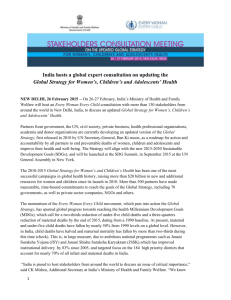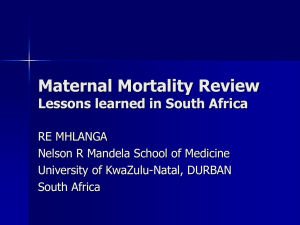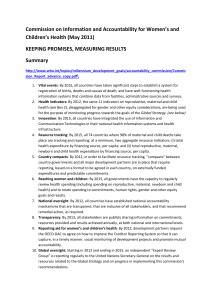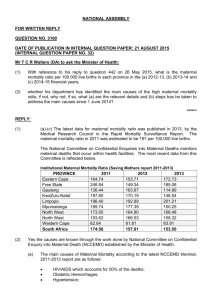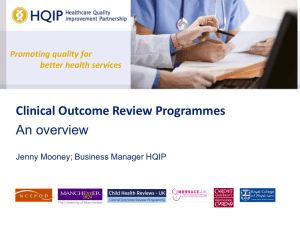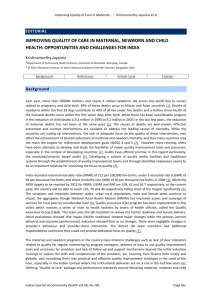A retrospective and prospective study of maternal mortality in a rural
advertisement
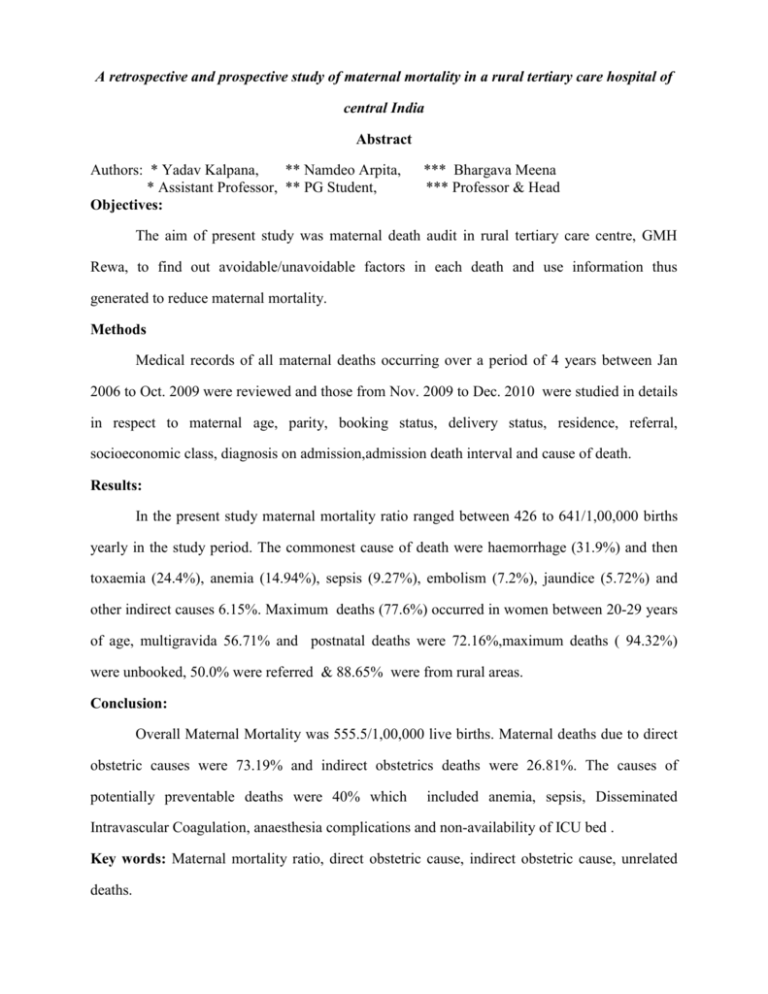
A retrospective and prospective study of maternal mortality in a rural tertiary care hospital of central India Abstract Authors: * Yadav Kalpana, ** Namdeo Arpita, * Assistant Professor, ** PG Student, Objectives: *** Bhargava Meena *** Professor & Head The aim of present study was maternal death audit in rural tertiary care centre, GMH Rewa, to find out avoidable/unavoidable factors in each death and use information thus generated to reduce maternal mortality. Methods Medical records of all maternal deaths occurring over a period of 4 years between Jan 2006 to Oct. 2009 were reviewed and those from Nov. 2009 to Dec. 2010 were studied in details in respect to maternal age, parity, booking status, delivery status, residence, referral, socioeconomic class, diagnosis on admission,admission death interval and cause of death. Results: In the present study maternal mortality ratio ranged between 426 to 641/1,00,000 births yearly in the study period. The commonest cause of death were haemorrhage (31.9%) and then toxaemia (24.4%), anemia (14.94%), sepsis (9.27%), embolism (7.2%), jaundice (5.72%) and other indirect causes 6.15%. Maximum deaths (77.6%) occurred in women between 20-29 years of age, multigravida 56.71% and postnatal deaths were 72.16%,maximum deaths ( 94.32%) were unbooked, 50.0% were referred & 88.65% were from rural areas. Conclusion: Overall Maternal Mortality was 555.5/1,00,000 live births. Maternal deaths due to direct obstetric causes were 73.19% and indirect obstetrics deaths were 26.81%. The causes of potentially preventable deaths were 40% which included anemia, sepsis, Disseminated Intravascular Coagulation, anaesthesia complications and non-availability of ICU bed . Key words: Maternal mortality ratio, direct obstetric cause, indirect obstetric cause, unrelated deaths. Introduction: Maternal mortality ratio (MMR) is number of maternal deaths (MDs) per 1,00,000 live births (LBs) during a given period. Maternal mortality rate is no of MDs in a given period per 1,00,000 women of reproductive age during the same period.1 Direct MD is the result of a complication of pregnancy, delivery or their management. Indirect MD is a pregnancy related death in a patient with preexisting or newly developed health problem. Other fatalities during but unrelated to pregnancy are non-obstetric/unrelated causes. Fortuitous or incidental causes are deaths from unrelated causes which happen to occur in pregnancy or puerperium (suicide, accident, murder).1 Every day 1000 women die during pregnancy and childbirth. Globally maternal mortality as estimated by WHO 201001 is 3,58,000 women per year, out of which 99.0% occurred in developing countries.2 Sub-Saharan Africa and South Asia accounted for 87% of maternal deaths. In developed countries MMR averaged at 14/1, 00,000 LBs, and in developing countries 290/1, 00,000 LBs. World wide MMR is 260/1,00,000 LBs.2 India contributes approximately 63,000 maternal deaths, each year. National average of MMR is 212/1,00,000 LBs. (RGI 2007-2009) Material and Methods: The present study was carried out in department of Obstetrics and Gynaecology ,SSMC & associated GMH, Rewa. This hospital is the solace for majority of poor rural women and covers a large chunk of population with a drainage area of 5 districts of Vindhya region namely Rewa, Sidhi, Satna, Shahdol, Umaria & Panna. The medical records of all MDs occurring in the peripartum period between Jan 2006 to Oct. 2009 were reviewed and MDs from Nov. 2009 to Dec. 2010 were studied prospectively irrespective of place of delivery and correlated with various factors like age, parity, booking status, delivery status,diagnosis on admission, admission death interval and cause of death. All women requiring hospital care were admitted irrespective of the availability of bed or antenatal registration in the hospital. Autopsy could not be conducted on any of the bodies due to lack of consent. Results and Observations: There were total of 36028 deliveries, 34,916 live births and 194 MDs during the study period from Jan 2006 to Dec 2010 . Year wise distribution of deliveries, MDs and yearly MMR are shown in Table 1 Table -1 Year wise distribution of deliveries and maternal deaths Years Deliveries Maternal MMR/1,00,000 Death Birth 2006 6495 27 426.33 2007 7497 37 506.78 2008 8236 45 568.61 2009 6444 40 641.33 2010 7356 45 631.04 34916 194 555.5 Total The average MMR was 555.5/1,00,000 births. Sociodemographic profile of maternal deaths is shown in table 2. Table -2 Sociodemographic Profile of Maternal Deaths SN Variable Age (in years) ≤19 20-29 30-39 ≥40 Gravidity I II III IV V & above Socioeconomic Status Low Low Middle Middle Upper Middle Upper Educational Status Educated Illiterate No. % 5 141 46 2 2.57 72.68 23.71 1.03 84 38 28 25 19 43.29 19.58 14.43 12.88 9.7 135 27 26 4 2 69.5 13.9 13.4 2.06 1.03 65 129 33.51 66.49 Relation of maternal deaths to booking status is shown in Table 3. Table -3 Maternal death in relation to booked and unbooked SN Cause of Death Antepartum Haemorrhage Postpartum Haemorrhage Toxaemia of Pregnancy Sepsis Rupture Uterus Obstructed labour Embolism Early Pregnancy Deaths Booked (n=14) 1 3 3 1 2 1 7.1 21.4 21.4 7.1 7.1 14.3 Unbooked (n=180) 3 1.7 34 18.9 44 24.4 15 8.3 15 8.3 13 7.2 9 5.0 3 - 21.4 - 29 8 8 1 2 16.1 4.44 4.44 0.5 1.1 - - 1 1 0.5 0.5 (Ectopic, Abortion, H. Mole) Medical Disorders Anemia Jaundice Malaria Gastroenteritis ARDS Others Anaesthesia complication Aspiration pnemonitis Different causes of death in antenatal, intranatal and postnatal period are illustrated in table 4. Table -4 Causes of death in antenatal, intranatal and postnatal period Cause of Death Direct Causes (n=142) APH PPH Obstructed labour Rupture Uterus Ectopic Pregnancy Vesicular Mole Toxaemia of Pregnancy Preeclampsia Eclampsia Sepsis Puerperal Postabortal Embolism Pulmonary Thromboembolism Amniotic Fluid Embolism Indirect Causes (n=52) Anemia Jaundice Malaria Gastroenteritis ARDS Others Antenatal (n=42) No. % 4 9.5 3 7.1 2 4.8 Intranatal (n=12) No % 1 8.3 - Postnatal (n=140) No % 37 26.4 14 10.0 - 2 10 4.8 23.8 2 2 16.6 16.6 11 20 7.9 14.3 4 9.5 - - 14 - 10.0 - 2 - 4.8 - - - 4 4 4 2.8 2.8 2.8 7 4 3 1 - 16.66 9.5 7.1 2.4 - 7 - 58.3 - 15 6 5 2 2 10.7 4.3 3.6 1.4 1.4 In our study the postnatal death rate was 72.16% (140/194), intrapartum 6.1% (12/194), antepartum 21.6% (42/194) including early pregnancy deaths of 5.15% (10/194) (Table 5). Table-5 Delivery method and maternal death Variable Antenatal (undelivered ) No. of Maternal deaths 32 Percentage (%) 16.49 Intranatal 12 6.18 Postnatal –Vaginal 92 47.42 Postnatal – LSCS 35 18.04 Postnatal-Exp. Lap. 13 6.70 Early Pregnancy Death 10 5.15 Total death 194 100.0 Among postnatal deaths 80.42% (103/140) were delivered in GMH & 19.58% (37/140) were delivered outside either at home or other health centre. Among institutional deliveries 53.3% (55/103) deaths were after vaginal delivery, 33.9% (35/103) after LSCS and 12.6% (13/103) after exploratory laparotomy following rupture uterus. Among all MDs 50% (97/194) were referred and 50.0% (97/194) were admitted directly. Majority of deaths 88.65% (172/194) were from rural areas and only 11.34% (22/194) were from urban places. Multigravida women had maximum MMR of 56.7% (110/194) and primigravida comprised 43.29% (84/194). Eighty percent of women died within 24 hrs of admission. Direct obstetric deaths occurred in 73.19% (142/194) & in 26.81% (52/194) indirect obstetric deaths. Direct obstetrics deaths include death from haemorrhage 43.6% (62/142), toxemia 33.09% (47/142), sepsis 12.67% (18/142) and embolism 10.5% (15/142). Year wise distribution of direct obstetric deaths is illustrated in table 6. Table-6 Year wise distribution of direct obstetrics death (n=142) Year No. (%) No. (%) No. (%) No. (%) Haemorrhage Toxemia Sepsis Embolism No. % 2006 6(9.6) 4 (8.5) 2 (11.2) 5 (33.3) 17 12.69 2007 12(19.35) 5 (10.6) 4 (22.23) 2 (13.3) 23 15.87 2008 14(22.58) 9 (19.1) 5 (27.78) 2 (13.3) 30 23.80 2009 14(22.58) 17 (36.1) 4 (22.23) 5 (33.3) 40 23.01 2010 16(25.80) 12 (25.5) 3 (16.67) 1 (6.6) 32 24.60 62 47 18 15 142 100.0 Total Total Haemorrhage accounted for 43.6% (62/142) of direct obstetrics deaths and included 61.21% (38/62) of deaths by primary PPH, 25.8% (16/62) by obstructed labour and rupture uterus, 6.45% (4/62) by placenta praevia, 3.2% (2/62) by ectopic pregnancy and 4.83% by vesicular mole. Toxemia cases accounted for 24.2% (47/194) of all MDS and included 31.9% (15/47) pre-eclampsia and 68.08 (32/47) eclampsia cases. Sepsis cases included puerperal 77.7% (14/18) & 22.2% (4/18) post-abortion. Indirect obstetric deaths occurred in 26.8% (52/194) women and included deaths due to anemia 55.7% (29/52), jaundice 23.06% (12/52) malaria 15.3% (8/52), gastroenteritis 3.85% (2/52) and ARDS 1.92% (1/52). Our study when compared with other Indian studies done in the last 15 years on the MMR and causes of MDs reveals a varying range of causes (Table -7) Table-7 Comparative Analysis Authors MMR Haemorrhage Toxemia % % % 302.6 21.05 10.52 7.89 2.63 345.9 21.8 20.0 21.6 15.4 518.7 12.7 22.97 9.45 25.40 Prasantha R10 2005 625 9.22 50.56 18.17 4.8 Puri et al4 2003-06 690 12 18 24 13 555.5 31.9 24.2 7.24 14.95 Vidhyadhar et al3 Sepsis % Anemia % 2006-10 Verma Ashok et al5 1995-2005 Mukherjee et al9 1996-2006 Present study 2006-2010 Discussion: MD is the death of women in relation to pregnancy. Women of rural areas lack awareness about antenatal care. Although blood transfusion facilities exist, may not rise to occasion due to unwillingness to donate blood. Too many, too frequent, too early child bearing and too late referral were the major contributory factors. Maternal deaths are not just result of poor or inaccessible medical care, but indicate a long chain of problems, lack of education for girls, early marriage, lack of access to contraception; poor nutrition and women's low social, economic and legal status. These factors, individually and collectively, contributed to women's poor health before and during pregnancy, increasing their vulnerability to life threatening complications and death. During the study period of 5yrs, there were 42,340 obstetric admissions, 36,028 deliveries, 34,916 live births and 194 maternal deaths, giving average MMR of 555.5 per 1,00,000 LBs. The MMR ranged from 426.33/1,00,000 LBs in 2006 to 641.33/1,00,000 LBs in 2009 (table 1), which is much higher than National MMR 212/1,00,000 LBs (RGI). Other Indian studies done in last 15 years have shown wide variations in MMR ranging from 302/1,00,000 (2006-2010)3 to 690/1,00,000 (2003-2006)4. This variation could be explained due to many variables. In this study MMR gradually increased, might be due to effect of Janani Suraksha Yojana (JSY), under NRHM, which on one side has tried to promote institutional deliveries to avert maternal deaths, on other hand maximally unbooked complicated patients reaches hospital in moribund state, without any antenatal visit. Promotion of transport vehicles also improved death reporting by carrying complicated cases like PPH, eclampsia which previously use to die in anonymity of their home or on the way to seek help at medical facility. Our study showed that 72.6% of women die between the ages of 20-29 yrs, as highest number of women belong to this age group. Our figure of 72.6% is closer with Puri et al4 (2006) at 71.53%, Verma Ashok et al5 at 78.5% and Vidyadhar et al3 at 68.0%. Multigravidas comprised 56.7% (110/194) while primigravidas 43.29% (134/194). Majority of deaths (69.5%) were in women belonging to low socioeconomic status. Most of the maternal deaths were in illiterate women (66.5%). Very high percentage of unbooked patients in maternal deaths (94.32%) highlight the importance of adequate antenatal care. Out of 14, 10 women were booked in other hospitals and 4 in our institution. In booked cases, no any death reported because of anemia, rupture uterus and sepsis. These 3 causes comprises of 32% of all MDS, which means these deaths can be prevented by improving booking status of women and also most of deaths from haemorrhage can be prevented as pre-existing anemia aggravates deaths from haemorrhage. It depicts the inability of utilization of available health care facilities by majority of local population. As per DLHS (2007-2008)6 in M.P., mothers who had three or more antenatal check ups (booked) were only 34.2% in rural areas and 58.3% in urban areas. Multigravida constitute 56.7% of MDS. Admission death interval of our study revealed that 60% of women died within 12 hrs of admission and another 20.0% in further 12 hrs, possibly due to poor general condition of women on admission, late referrals and at times due to a long travel time from neighboring districts. In our study postnatal death rate was 72.16% and included 53.3% after vaginal delivery, 33.9% after LSCS and 12.6% after exploratory laparotomy, Purandare et al7 also found 73.33% death in postpartum period. The analysis revealed that 73.19% of deaths are due to direct obstetric causes and 26.8% due to indirect obstetric causes. Our figure of 73.19% is closer with Kulkarni et al8 at 68.7% and Mukharjee S et al9 at 61.24%. Percentage variation of indirect obstetric death ranges between 40.0%8, 38.64%9 and 26.8% our study. In our study 72.1% (140/194) on MD's were in postnatal period, 21.6% (42/194) in antenatal period & 6.1% (12/194) in intranatal period. Majority of deaths from haemorrhage (37/46) were in postpartum period. 62.5% (20/32) of eclamptic women and 73.3% (11/15) of pre-eclamptic women died in postnatal period. Majority of deaths in intranatal period were because of anemia (7/12). Common direct causes of maternal deaths in decreasing under of frequency were, haemorrhage 31.9%, toxemia 24.2%, sepsis 9.27% and embolism 7.7%. Haemorrhage especially during postpartum is sudden, unpredictable and is more dangerous when women has pre-existing anemia. Globally, as per (WHO, 2007)2 estimates 25.0% of all maternal deaths are due to haemorrhage, similarly in various Indian studies incidence of haemorrhage varies from 9.2%10 to 21%3. In present study, haemorrhage accounted for 31.9% of all deaths. Out of 62 cases of haemorrhage, 38 (61.29%) died within 12 hrs of admission, 70.0% of all haemorrhage cases died of hypovolumic shock. Lack of immediate availability of blood in blood bank and unwillingness to donate blood is major contributory factor in our hospital. Eclampsia & PIH accounts for 13.0% maternal deaths globally (WHO, 2007)2, other studies reveal a large variation in eclampsia deaths between 16.3% (Salhan et al)11 and 50.56%10. Our study had eclampsia deaths of 16.5%, year wise analysis revealed gradual increase in deaths, could be due to lack of junior doctors in hospital, increase in number of admission of more complicated cases, lack of ICU in department. Sepsis which is a direct consequence of poor hygiene during delivery accounts for 15.0% of MDs globally (WHO, 2007)2. In comparative analysis it varies between 7.89%3 and 24.0%4. In our study, it was only 7.2% which is quit less. Year-wise analysis of our study showed a range between 6.6% to 11.1%. Inspite of emergence of multidrug resistant strains of bacteria and overcrowding of obstetric wards throughout the year, this controlled incidence of sepsis might be due to maintenance of strict asepsis during delivery, caesarean sections and proper use of antibiotic prophylaxis and use of broad spectrum antibiotics during treatment of high risk cases for sepsis. Globally indirect obstetric causes accounts for 20% of all MDs particularly from anemia, jaundice, malaria etc2. Other Indian studies show this range between 17.2% (Bichli et al)12 and 40%7. In our study it was 26.3% and included deaths due to anemia (14.9%), jaundice (6.2%), malaria (4.1%), gastroenteritis (1.03%) and ARDS (0.5%). According to WHO (2007)2 in developing countries deaths due to anemia varies between 12-17%. In our study it was 14.9%. Comparative analysis of other Indian studies show deaths due to anemia ranges from 2.63%3 to 25.0%9. In our study, deaths due to haemorrhage (23.7%), hypertensive disorders of pregnancy (24.2%), anemia (14.9%), sepsis (9.2%), rupture uterus/obstructed labour (8.2%) and anaesthesia related complication (0.5%) were preventable and accounted for 81% (157/194) of all maternal deaths. These deaths can be prevented through proper understanding, diagnosis and management of labour complication. Lack of blood in blood bank and preexisting anemia were the aggravating factor in deaths from haemorrhage. Active management of third stage of labour (AMTSL) can prevent many of these deaths. Sepsis is probably the most easily preventable cause of maternal death. Strict asepsis during delivery, proper use of antibiotic prophylaxis in high risk cases for sepsis, easy availability of MTP services to prevent unsafe abortions, all these can prevent most of the deaths due to sepsis. Improving the number of booked patient especially grand multigravidas, availability of safe blood and positive approach towards life saving surgery can reduce maternal death to great extent. By strengthening four pillars of safe motherhood including family planning, antenatal care, clean safe delivery and essential obstetric care, the increase in maternal mortality can come to a halt. Conclusion The classical triad of causes of maternal mortality in our study remained haemorrhage, toxemia and sepsis in the same order. According to the WHO report (2005) "make every mother and child count" haemorrhage is the leading cause of death. The present study highlights the importance of early antenatal registration of all pregnancies and regular follow-up of cases by trained staff. Poor nutritional status, lack of antenatal care, unawareness of warning signs of pregnancy, unsupervised dai handled deliveries, social bias towards blood donation and late referrals are the major contributory factors leading to poor maternal prognosis. The lesson learnt through review of records of MDS have helped us to identify the high risk group, solely for the purpose of improving service delivery by ascertaining the cause of death, reasons for inability to provide appropriate care at appropriate time and finding the key interventions at service delivery level to prevent similar deaths. There should be active management of high risk group by frequent ANC visits, direct consultant supervision, liberal use of CTG, biochemical markers, fluid and component transfusions, aggressive management of infection and closer monitoring of women in labor. High fertility and unwanted pregnancies should be reduced through family welfare services and easy availability of MTP services to be ensured. Analysis of every maternal death through maternal death audit, either at community level (verbal autopsy) or at the institutional level should be carried out. Vigorous mass campaign for community based maternal education programme should be the top priority of maternal and child health programs. References: 1. Maternal death. http://en.wikipedia.org/wiki/ maternal death. 2. Trends in maternal mortality: 1990 to 2008. Estimates developed by WHO, UNICEF, UNFPA and the world bank. World Health Organization, Geneva 2010. 3. Vidhyadhar B, Purushottam A, Giri B, Garg RC. Maternal mortality at a tertiary care teaching hospital of rural India, a retrospective study. Int J Biol Med Res. 2011;2(4):1043-6. 4. Puri A, Yadav I, Jain N. Maternal mortality in an urban tertiary care hospital of North India. Indian Journal of Obst Gynnecol. 2011;61(3):280-285. 5. Verma A, Minhas S, Sood A. A study on maternal mortality in Dr. Rajendra Prasad Govt. M.C. Tanda Dist. Kangra, H.P. (Jan. 1999-Dec. 2005). Indian J Obst Gynecol. 2008;58(3):226-9. 6. IIPS, District Level Household and Facility. DLHS-3 state facts sheets 2009, <http://www.rchiips.org/state fact_sheet, accessed Jan 26, 2009. 7. Purandare N. Singh A, Upadhya S et al. Maternal mortality at a referral center, a five year study. J Obstet Gynecol India 2007;57(3):248-250. 8. Kulkarni S, Athani S, Seetaram S. Maternal mortality of Head Quarter Hospital, Bellary. J Obster Gynecol Ind. 1996;46(4):492-6. 9. Mukherjee S, Theengh C, Bhattacharya S, Maru L. Maternal mortality at a tertiary care institute of central India. Asian Journal of Obst & Gynae practice. 2010;4:23-7. 10. Pal A, Prasantha R, Samir H, Mondal TK. Review of changing trends in maternal mortality in a rural medical college of West Bengal. J Obst Gynecol Ind. 2005;55(6):5214. 11. Salhan S, Sharma M, Suri J. Maternal mortality in a tertiary hospital.JOSH 2000;7:78-79. 12. Bichli L, Razvi NA. Maternal mortality (an analytical study). J Obstet Gynecol Ind. 1995;45:901-905.




